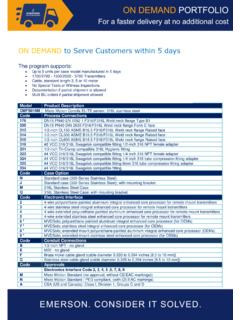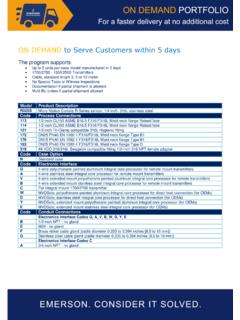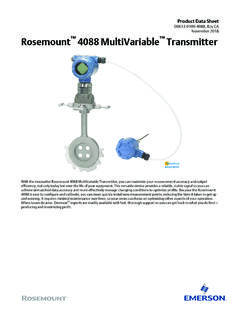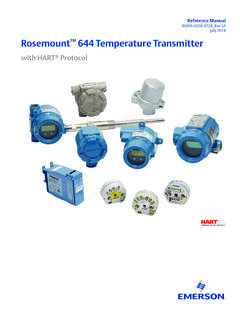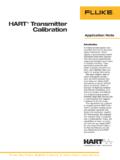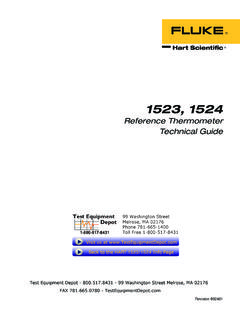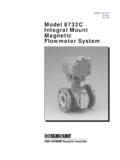Transcription of DeltaV SIS HART Capabilities - Automation Solutions
1 DeltaV SIS Whitepaper DeltaV SIS Process Safety System September 2013. DeltaV SIS hart Capabilities This document describes various hart Capabilities that can be used with the DeltaV SIS system. In addition, best practices for the implementation of SIS hart diagnostics in the SIS and BPCS are detailed. DeltaV SIS hart Capabilities September 2013. introduction hart diagnostics in SIS field devices have been used for many years by several different SIS vendors. hart diagnostics provide much more information on the health of a field device than can be determined from a standard 4-20 mA signal. For this reason, greater SIL. (by turning Dangerous Undetected failures into Dangerous Detected failures) and longer proof testing intervals can be achieved by integrating intelligent field devices into the SIS field devices running hart diagnostics. Most SIS vendors do not have the capability to use the hart diagnostics in the SIS logic. Instead, their systems simply use hart .
2 Multiplexers to strip off the hart signal, usually on a Field Termination Assembly (FTA), and then send the hart signal to a separate AMS platform to alert the maintenance group of unhealthy devices. These systems do not have the capability of using the hart . diagnostics directly in the SIS logic. Nor do these systems have the capability of efficiently generating operator graphics, alarms, or historization of the device diagnostics. The DeltaV SIS, however, has the capability to either pass on the diagnostics to an Asset Management System (AMS) or the Basic Process Control System (BPCS) or to use the diagnostics in the SIS logic. This capability has many added benefits over traditional SIS: The SIS can use the hart diagnostics to determine if a field device is unhealthy. If the device is unhealthy, the SIS can take action to remove the device from voting or trip the system if required. The hart diagnostics can be displayed on detailed operator faceplates or displays to efficiently alert the operator and the mainte- nance group of unhealthy devices.
3 Historization of hart alarms can be recorded with the same tool as the BPCS and SIS alarms. The alarm banner on the operator graphics can show hart alarms, which will quickly alert the operator of critical devices that are unhealthy and require greater monitoring from the operator. Different hart signals can be used to monitor and alarm various conditions in the field without the requirement to run separate wiring for these signals - resulting in significant cost savings. This document will review several hart parameters and best practices to be used in the application of hart in the DeltaV SIS to ensure its Capabilities are fully realized. This document also uses Rosemount and Fisher device Capabilities to describe the hart . protocols. Other vendors may use slightly different configuration/functionality for their hart devices. Specific DeltaV SIS hart Parameters Built-in hart Device Status Signals The DeltaV SIS automatically reads various hart status signals from transmitters and the DVC6000 series positioner.
4 The system can also determine device health based on these parameters. These parameters can be configured to assign a faulty status to the device and perform the following: Degrade transmitter voting If a transmitter is determined to be bad via these built-in hart status signals, the SIS can either remove the transmitter from the voting logic ( a 2oo3 voted group of transmitters degrades to 1oo2 or 2oo2 with the bad trans- mitter viewed as faulty) or the transmitter can be alarmed simply via operator graphics. Trip a valve While unlikely to be used due to availability concerns, the built-in hart device status signals can be used to trip valves that use a hart -enabled positioner or alarm the valve via operator graphics. The following built-in hart device status signals (shown below) are used: PV out of limits Analog-digital mismatch PV output saturated PV output fixed Loss of digital communications Field device malfunction. 2. DeltaV SIS hart Capabilities September 2013.
5 It is up to the end user to determine if these status signals should be used for transmitter voting degradation or tripping of valves. Configuration of these built-in hart status signals that affect transmitter or valve status within the DeltaV SIS logic can be performed via the DeltaV . Explorer. After creating a hart -enabled channel in a CSLS (CHARM Smart Logic Solver) hart -enabled analog input or DVC output CHARM, drill down into the channel and double click on the HART_ERRORS parameter. By default, the CSLS will ignore all of the built-in status signals. PV Out of Limits The hart instrument is reporting that the primary variable read by the transmitter is outside of the 4-20 mA range. This signal can be used to detect open/short circuits in the transmitter wiring. Analog-Digital Mismatch The hart instrument is reporting a difference between the analog 4-20 mA signal and the digital PV signal. This functionality can be used to determine a small ground in the home run cable to the instrument or an intermittent device.
6 If a ground loop exists in the loop, the trip limit of the device may never be reached even under trip conditions due to earth leakage. This diagnostic should detect the difference and the SIS can perform the required action (trip or alarm). PV Output Saturated Shown above, the analog and digital signals for the Process Variable are beyond their limits and no longer represent the true applied process. If the process variable goes outside of the 4-20 mA range, the hart transmitter will drive the mA. output and the PV to the saturation values, but no further. The transmitter will clamp the analog output and PV to the saturation values (not the 4 and 20 mA values). PV's between the 4-20 mA limits and the saturation limits may still be valid signals. The following diagram is taken from a Rosemount 3051S pressure transmitter user manual. The low and high saturation ( mA. and mA respectively in the Alarm Level) are the saturation setpoints. The mA and mA values are the transmitter failure setpoints: 3.
7 DeltaV SIS hart Capabilities September 2013. It should be noted that this is a digital hart alarm that is separate from the open/short circuit detection performed by monitoring the 4-20 mA analog signal in the CSLS. Usually, SIS transmitters are configured in the CSLS to detect faulty transmitters (open/short circuit) by monitoring the 4-20 mA analog signal and removing a transmitter from a voting configuration when that analog signal is outside of a specified range. It is good engineering practice to set the faulty transmitter ranges for the 4-20 mA analog value in the CSLS equal to the failure alarm setpoints from the hart device. If the transmitter detects an error, it will send the PV to the failure alarm setpoint. Values within the low/high saturation areas are still valid values according to the transmitter. If faulty transmitter setpoints using the 4-20 mA signal in the CSLS are set within the saturation range, spurious trips of the process may occur even though the transmitter may not be faulty.
8 PV Output Fixed - The analog and digital signals for the Process Variable are held at the requested value. They will not respond to the applied process. The output is fixed when a transmitter has been taken out of service during calibration or maintenance (changing a range, for example). Unless the transmitter has been put back in service, the outputs will continue to be fixed indefinitely. Loss of Digital Comms This status bit is set when the hart digital communications with the device is lost. The 4-20 mA analog signal may still be valid, but the digital hart signal is not available. Field Device Malfunction - The device has detected a hardware error or failure on the device. This pertains to a variety of errors that can occur. Malfunctions in the memory, A/D converters, CPU, etc are covered under this status bit. Additional hart Parameters In addition to the built-in hart status bits, several other hart variables can be used. These hart variables are dependent on the type of device.
9 While the status signals can be used directly in the SIS logic, these additional hart parameters pass through the SIS. to the BPCS and AMS. If these parameters are to be used in SIS logic, they must first be programmed in the BPCS as a parameter reference and then sent down to the SIS logic. It should be noted that hart is not a safety-rated platform. You should NEVER substitue hart signals for hardwired signals when the hardwired signal is being used to detect a hazardous condition with a SIL rating. For example, valve position is a hart . parameter in the DVC6000 series positioner. If valve position is being used to detect a hazardous condition with a SIL rating, the valve position must be read using limit switches or position transmitters. However, if valve position is a diagnostic used to determine the status and health of the valve, then the hart parameter can be used. hart should only be used for diagnostic purposes. Fisher DVC6000 Series Positioner Most Rosemount devices use the HART_PV, HART_SV, HART_TV, and HART_FV variables to send configurable device information to the DeltaV and DeltaV SIS.
10 The Fisher DVC6000 series positioner sends four configurable slot variables in addition to the hart . variables (which are not configurable in the DVC6000 series positioner). The available hart variables are:: HART_PV Loop Current, mA or %. HART_SV - Auxiliary Contact Status, 0 or 100%. 4. DeltaV SIS hart Capabilities September 2013. HART_TV - Output Pressure, psi, bar, or kPa HART_FV - Travel, %. Partial Stroke Testing (PST) Initiating a partial stroke test and the success of the partial stroke test are hart parameters that are used in the DVC6000 series positioner. The partial stroke test can be initiated in the DeltaV SIS, AMS, an operator graphic, or via a hart handheld device. The test is run in the DVC6000 series positioner and the success/failure of the test is sent back to the SIS. and/or AMS to be shown on operator graphics or for historization. It is good engineering practice to include the requirement for a successful partial stroke test during any commissioning process for a valve with a DVC6000 series positioner.
